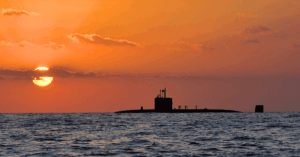
World’s Largest Shipping Association Adopts Clause To Address USTR Actions
July 23, 2025
Foreign Ships Now Need Approval From Russia’s Top Security Agency To Enter Its Ports
July 24, 2025

The Royal Navy has officially retired HMS Triumph, marking the end of the Trafalgar-class submarine era after more than four decades of service.
The formal decommissioning ceremony was held at HM Naval Base Devonport in Plymouth, England, where generations of submariners gathered to celebrate the legacy of the “T-boats.”
The Trafalgar class, built during the Cold War and comprising seven nuclear-powered attack submarines, had been a key part of the UK’s underwater warfare capabilities since the early 1980s.
These submarines, known for their speed, stealth, and striking power, supported intelligence-gathering missions, Tomahawk missile strikes, and covert operations around the world.
HMS Triumph was the last operational submarine of the class and had served the longest, 34 years in total. It was commissioned in 1991 and followed earlier vessels Trafalgar, Talent, Turbulent, Torbay, Tireless, and Trenchant. Since 2009, they’ve been gradually replaced by the more advanced Astute-class submarines.
Veterans and families attended the formal parade, which featured a Colour Party and Guard of submariners from Triumph and Talent, supported by Royal Naval Associations and the Royal British Legion.
Captain Dave Burrell, who had served on multiple T-boats and once commanded HMS Trenchant on a mission to the North Pole, shared his experiences during the event. He described the Trafalgar-class submarines as “utterly brilliant” and said they had become a second home to many who served aboard them.
Utterly. Brilliant. Boats.
The Trafalgar class of hunter-killer submarines passed into history with the decommissioning of HMS Triumph in @HMNBDevonport, the last of 7 T boats which have patrolled beneath the waves for more than four decades.
https://t.co/lBZKCeUOmN pic.twitter.com/mhTFrFPBHS
— Royal Navy (@RoyalNavy) July 21, 2025
Captain Burrell also paid tribute to the crew of HMS Tireless who responded heroically during a deadly onboard explosion in 2007 while patrolling the Arctic. Two Weapons Engineers, Paul McCann and Anthony Huntrod, lost their lives in that incident, which he considered one of the defining moments in the class’s history.
T-boat veteran and former nuclear engineer Craig Spacey said the submarines were known for their strong onboard camaraderie. Though missions were often secret, he said the crew bond and sense of purpose kept submariners in service.
The T-boats were initially built to shield the UK’s Trident nuclear missile submarines from Soviet threats. However, after the Cold War, their role evolved. HMS Triumph, for example, launched Tomahawk missiles at Taliban targets in Afghanistan in 2001 and later struck Libyan targets during NATO operations in 2011.
Built by Vickers Shipbuilding and Engineering in Barrow-in-Furness, each of the Trafalgar-class submarines was 280 feet long, displaced 5,300 tons submerged, and was powered by a Rolls-Royce pressurised water nuclear reactor. Their armament included Spearfish torpedoes and Tomahawk Land Attack Missiles with a range of over 1,200 miles.
HMS Agamemnon and HMS Achilles, still under construction, are expected to replace Talent and Triumph, respectively, in the Royal Navy’s attack submarine force by the end of the decade.
Reference: Royal Navy
Source: Maritime Shipping News


